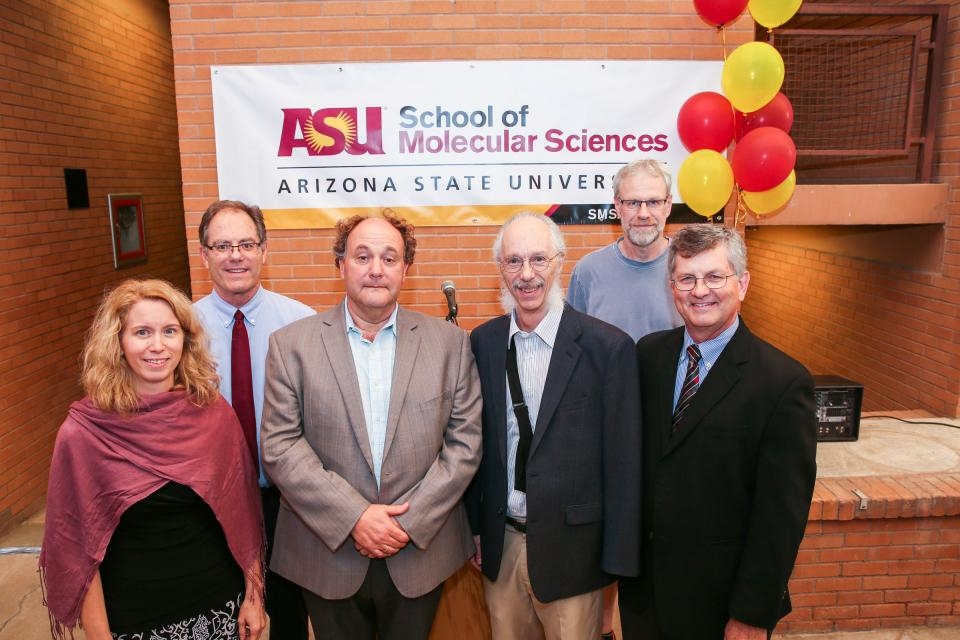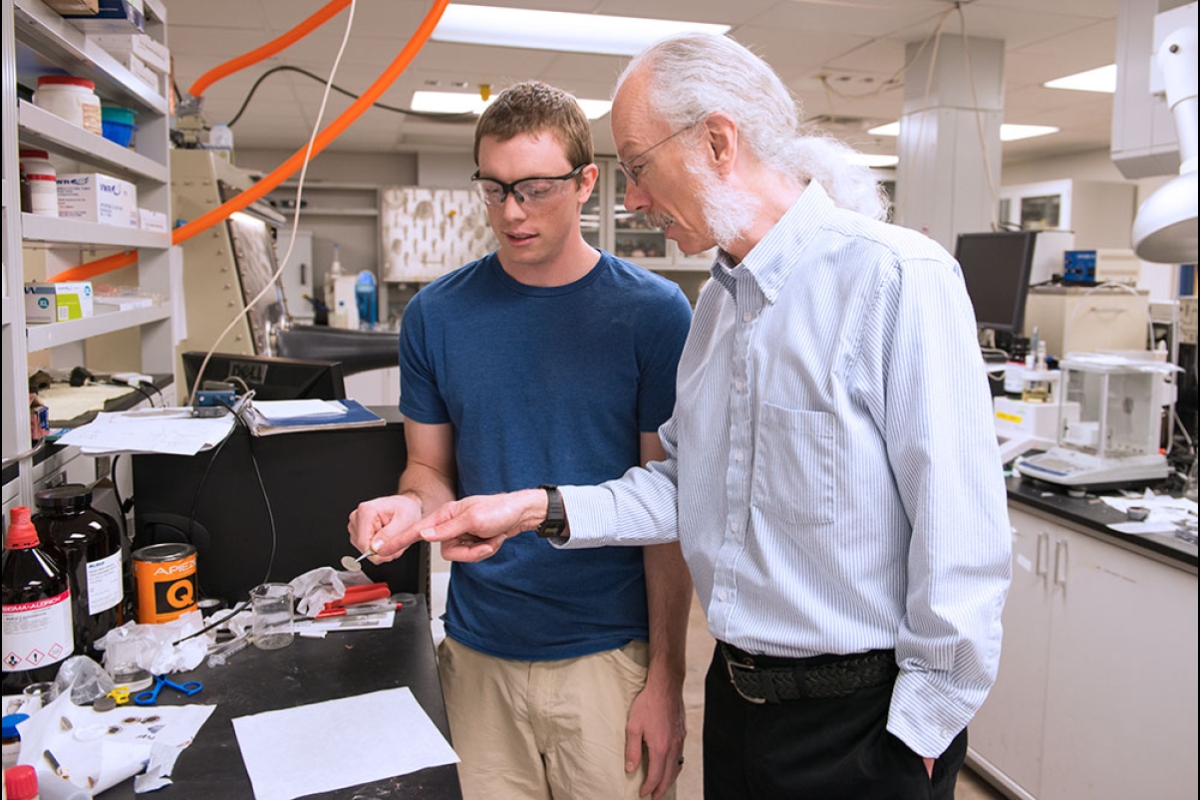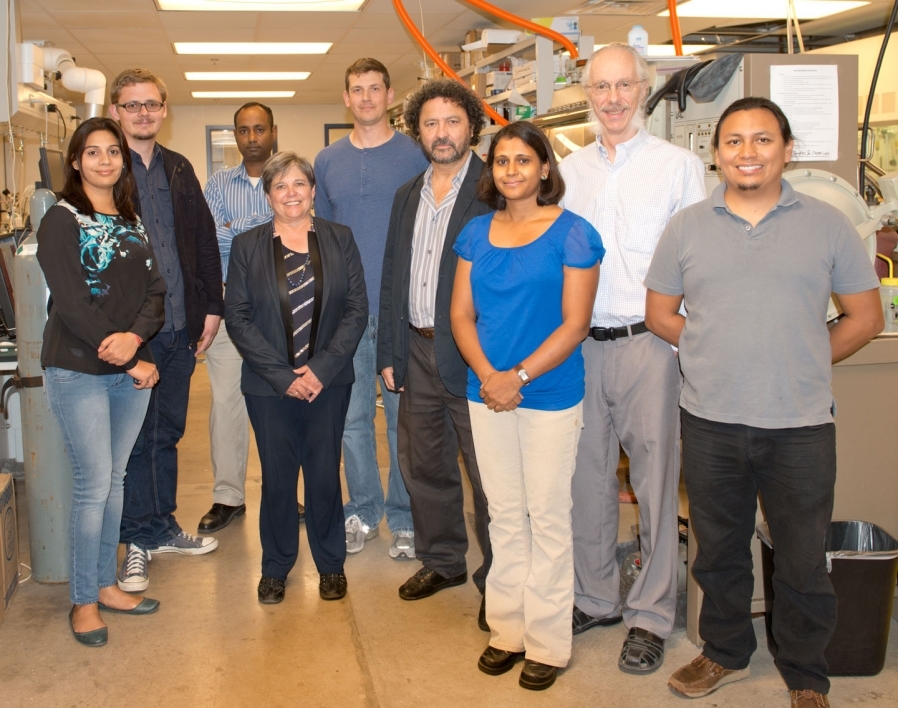School of Molecular Sciences inaugural director retires after exemplary ASU career

Professor Dan Buttry is retiring from ASU's School of Molecular Sciences. Photo by Mary Zhu/ASU
Professor Daniel Buttry, inaugural director of Arizona State University's School of Molecular Sciences (SMS) and an expert in the fields of electrochemistry and materials science, is retiring after 40 years (14 at ASU) of exemplary teaching, research and leadership roles.
“Dan has been an intellectual leader in electrochemistry and related materials science, particularly as it pertains to the key topics of batteries and fuel cells,” said Professor Neal Woodbury, vice president of research and chief science and technology officer of ASU Knowledge Enterprise. “During his time as SMS director, he played a major role in establishing the new school and moving it forward productively.”
Buttry earned a BA in chemistry from the University of Colorado at Colorado Springs in 1979 and a PhD working with Fred Anson from California Institute of Technology in 1983. After working at the IBM Almaden Research Laboratories in San Jose for two years, he accepted a position at the University of Wyoming as assistant professor in 1985, earning tenure in 1989 and promotion to full professor in 1992. At Wyoming he served as department chair from 1999–2002.
Buttry moved from the University of Wyoming to ASU in 2008 and succeeded Bill Petuskey as chair of the department of chemistry and biochemistry in 2012. He led the transformation from an academic department to the new School of Molecular Sciences in 2015, becoming the inaugural school director. The establishment of a new school was an important step in that it was the first public and visible declaration by any department of chemistry or biochemistry in the U.S. that a focus on the academic disciplines of chemistry and biochemistry was no longer consistent with societal demands for scientific enterprise in the 21st century. The new school is not discipline-focused but has a mission of addressing societal problems from an atomic and molecular perspective, and advancing research and discovery of public value, in accord with the ASU Charter.
“Under Dan’s leadership, the department saw significant growth and expansion in research in bioanalytical chemistry, nanotechnology and computational and theoretical chemistry, and underwent one of the most visionary realignments attempted by any chemistry department in formation of the school,” said Ian Gould, former SMS interim director.
Anne Jones, vice provost for undergraduate education at ASU and a professor in the School of Molecular Sciences, said, “Dan was ideal to lead SMS as inaugural director because of his broad interests in chemistry and his willingness to serve others. No matter the corner of chemistry, Dan is always up to speed and can quickly offer suggestions, a paper to read, a collaborator to contact or an experiment to try. Those qualities have made him sought-after as both a researcher and an administrator.”
Buttry said he is extremely grateful to Jones and Gould for their innovative help and unfailing support as associate directors in helping build the new school.
He said he is also very appreciative for the wonderful collaborators he found at ASU, including Karl Sieradzki, Cody Friesen, Vladimiro Mujica, Tarakeshwar Pilarisetty, Jeff Yarger, Greg Holland, Austen Angell, Gould, Ray Carpenter, Jimmy Liu, Candace Chan, Peter Crozier and Bob Nemanich. Buttry said, “All the big money I got was always collaborative with these really terrific colleagues that I had at ASU.” And he feels that these collaborations enabled science that could never have been done “without such a broad range of expertise, something ASU is well known for."
Buttry has published over 100 papers and 18 patents in the general areas of electrochemistry, interfacial chemistry, thin films, nanomaterials, sensors and battery chemistry. He made widely cited contributions on the use of the quartz crystal microbalance (QCM) to measure interfacial chemistry at electrodes, and the mechanisms of charge migration in organic thin-film devices.
“If you ask anybody what I've worked on, QCM work would be the first thing they would say,” Buttry said. “I learned all about it from a wonderful guy at IBM called Kay Kanazawa. I learned how to build one and how to interface it to electrochemical equipment and then, with their blessing, moved off to Wyoming and set one up and started working in that area.”
There were only a couple of instruments anywhere in the world doing the combination of QCM and electrochemistry at that time.
Buttry also worked on the development of a new generation of lithium and magnesium ion batteries. His most recent work focused on new methods for the controlled capture and release of carbon dioxide to ameliorate the effects of point source emitters such as power stations, for which he received a $3.75 million grant from the Department of Energy’s Advanced Research Projects Agency.
Buttry made significant service contributions to the fields of electrochemistry and materials chemistry, serving on the editorial board of the journal Langmuir and on the board of the Society for Electroanalytical Chemistry. He also helped to organize many important scientific meetings and conferences in his field, and he chaired the Gordon Research Conference on Electrochemistry.
Even though he is retiring, Buttry said he is extremely passionate about helping to solve our climate change problem. He will continue to work on carbon capture but says that there should be a fiercer urgency to tackle the problem, using an “all of the above” approach to reduce the amount of carbon dioxide in our atmosphere.
Buttry has always enjoyed teaching both undergraduate and graduate students, and taught a graduate electrochemistry class online during the last couple of years. Ironically, he expressed that the dynamic of the class became a lot more personal over Zoom, with students interrupting and asking a lot of questions, which was extremely beneficial for everyone.
“Dan was an important member of the SMS faculty; his expertise was unique in that he was just as comfortable thinking about fundamental chemistry as the design of practical and workable applications of chemistry. He had a very deep understanding of basic chemistry, could talk meaningfully on any chemistry topic and was kind, generous and helpful. We wish him all the best in his retirement, but he will be truly missed,” said Gould.
Ian Gould contributed to this story.
More Science and technology

ASU-led space telescope is ready to fly
The Star Planet Activity Research CubeSat, or SPARCS, a small space telescope that will monitor the flares and sunspot activity…

ASU at the heart of the state's revitalized microelectronics industry
A stronger local economy, more reliable technology, and a future where our computers and devices do the impossible: that’s the…

Breakthrough copper alloy achieves unprecedented high-temperature performance
A team of researchers from Arizona State University, the U.S. Army Research Laboratory, Lehigh University and Louisiana State…




